Key takeaways:
- Building trust through empathy, vulnerability, and consistent interactions fosters deeper relationships between educators and students.
- Active listening, including allowing moments of silence, encourages students to share their thoughts and feelings more openly.
- Incorporating personal stories into lessons enhances engagement, making topics more relatable and memorable for students.
- Maintaining connections outside the classroom through simple gestures and extracurricular involvement strengthens student relationships and trust.
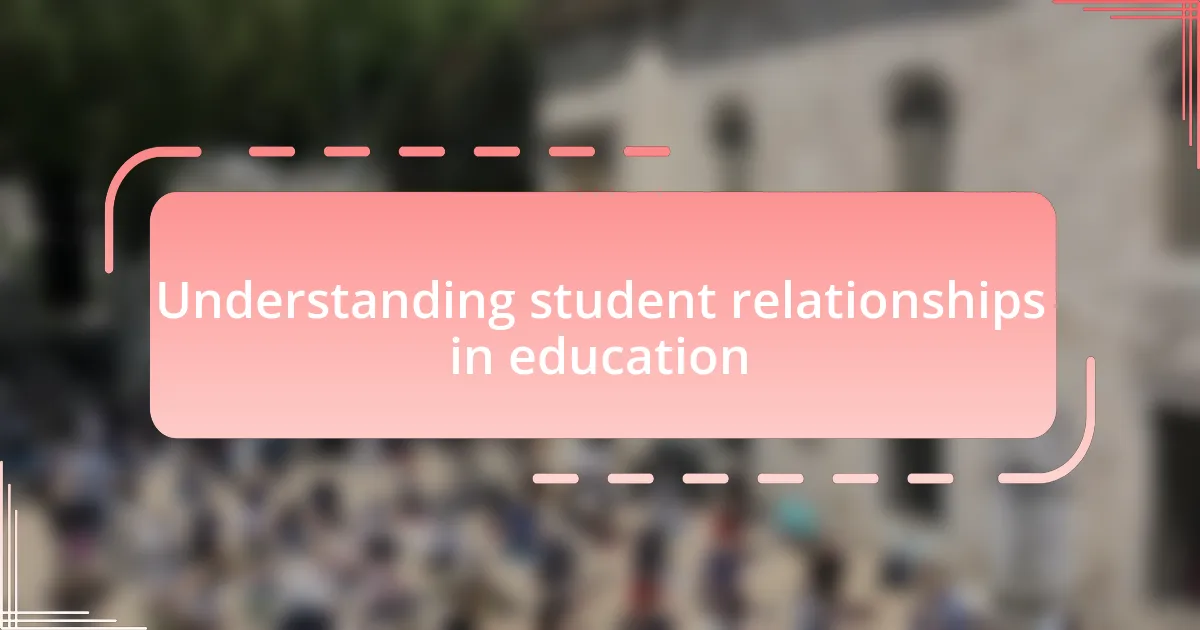
Understanding student relationships in education
Understanding student relationships in education goes beyond mere academic interaction; it’s about creating a supportive environment where students feel valued. I remember a time when a student opened up to me about their struggles at home. That moment deepened our relationship and changed the dynamics of our communication; they were no longer just a face in the classroom but an individual with unique challenges.
Building genuine relationships often hinges on empathy and trust. Have you ever noticed how a simple acknowledgment of a student’s feelings can foster deeper connections? I once shared a personal story of my own struggles, which encouraged a student to share theirs. This gave us a common ground and made our educational journey more meaningful.
As educators, we must recognize the importance of listening. There have been instances when just taking a moment to sit down with a student made all the difference. I could see their posture shift from defensive to open, and it became clear that understanding student relationships involves actively engaging with their perspectives and emotions.
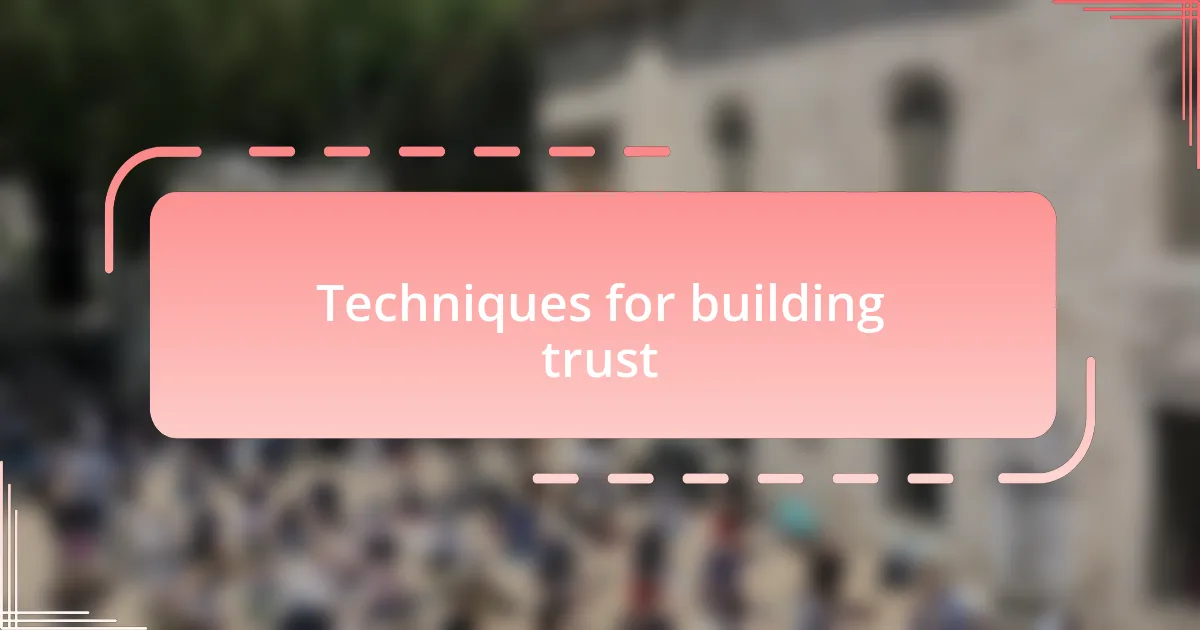
Techniques for building trust
One effective technique for building trust is consistency in how I approach each student. I remember early in my career, I was a bit uneven with my responses—sometimes supportive, other times distracted. But as I began to treat every interaction as important, students responded by sharing more openly with me. They knew I would be there, ready to listen, and that reliability itself became a foundation for our relationship.
Another key element is vulnerability. I was once in a classroom where a student faced severe anxiety about speaking in front of peers. I took a leap and shared my own fear of public speaking, which surprised them. Suddenly, I was not just an authority figure but someone who understood their struggle. This openness allowed them to trust me more fully, reinforcing the idea that vulnerability can be a powerful tool in relationship-building.
And let’s not overlook the role of genuine interest. I often ask students about their hobbies or interests outside of school. Just last week, I engaged a student in a discussion about their favorite books. Their eyes lit up, and I could see how it sparked a connection beyond academics. When students feel valued for who they are beyond their grades, it fosters a deeper trust and enriches our educational experience together.
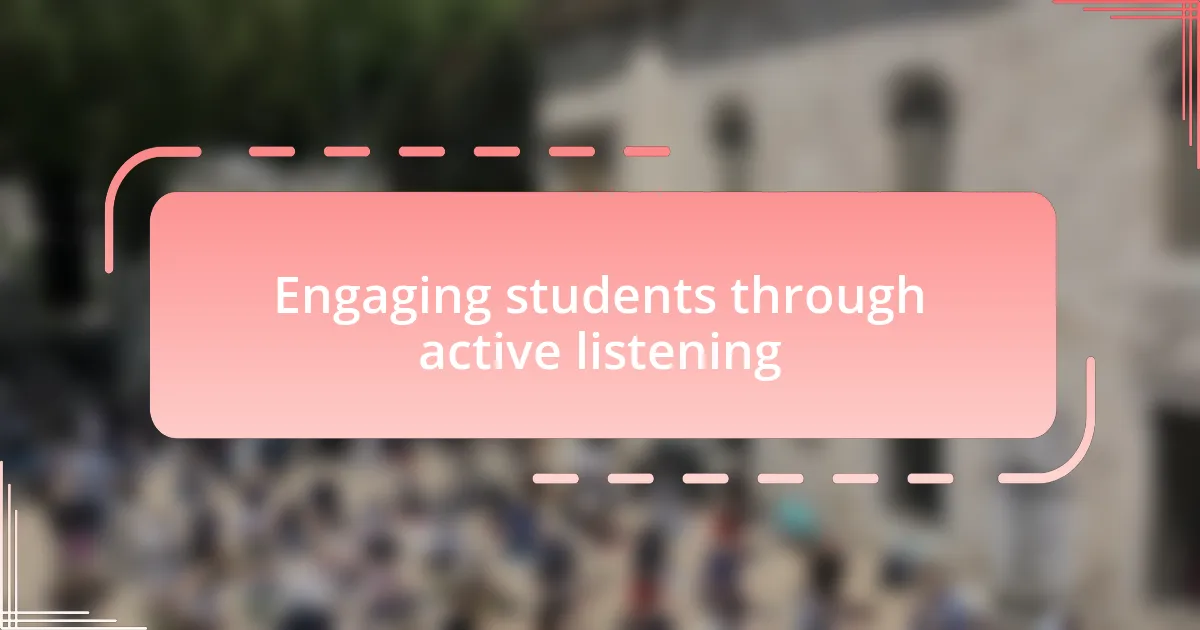
Engaging students through active listening
Active listening has been a game changer in my interactions with students. I once found myself in a discussion with a student who was struggling with their faith. Instead of jumping in with advice, I focused solely on listening. I leaned in, maintained eye contact, and allowed pauses for them to share their thoughts. This simple act made them feel heard and reduced their apprehension, showing me the transformative power of truly listening.
There are moments in the classroom where silence speaks louder than words. I distinctly remember a time when a student shared an experience that made them question their beliefs. Instead of filling the space with my own thoughts, I let the silence linger, encouraging them to delve deeper. In those moments, I observed how students would open up more fully, revealing layers of their thoughts and feelings. Isn’t it fascinating how, when we listen actively, we create a safe sanctuary for students to explore their inner worlds?
I often remind myself that conversations aren’t just about exchanging words—they’re about building connections. I take care to reflect on what students say, occasionally summarizing their points to show I understand their perspective. I recall a late afternoon when a student shared their struggles about balancing faith with peer pressure. By mirroring their concerns, I could see their relief—recognition that someone is truly in their corner. Active listening engages students on a deeper level, paving the way for richer conversations and stronger relationships.
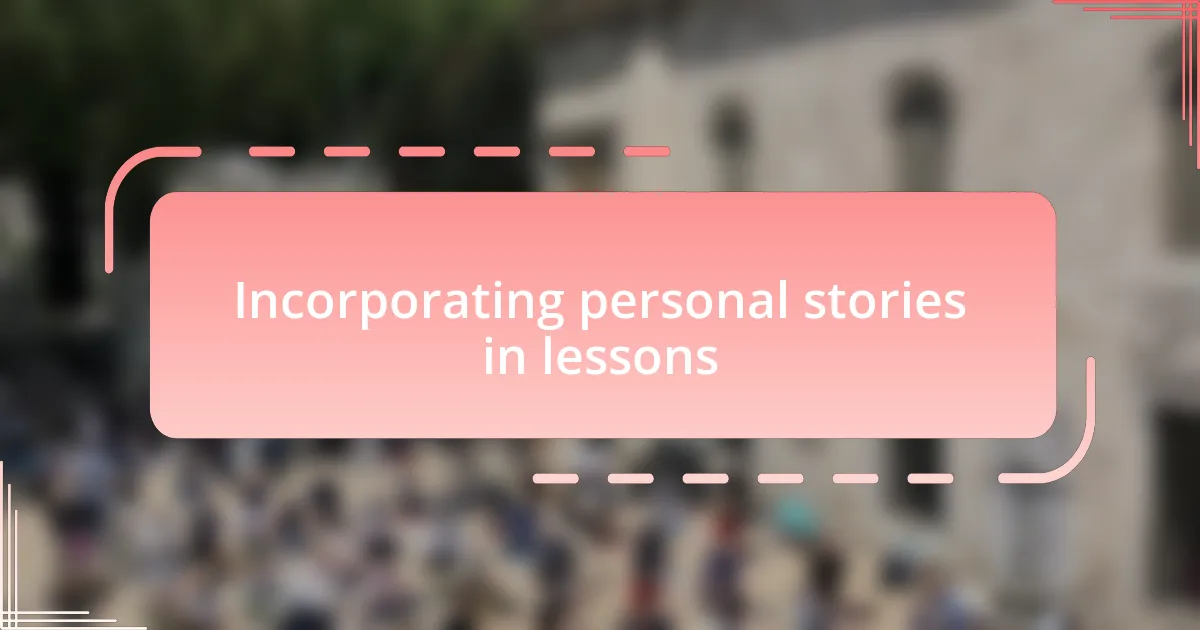
Incorporating personal stories in lessons
Incorporating personal stories into lessons can create a profound connection between the teacher and students. I remember one lesson where I shared a pivotal experience from my childhood involving faith and resilience. The moment I revealed my doubts and the journey I took to find clarity, I could see students leaning in, nodding, and even smiling in recognition. It ignited a conversation about their struggles, as they began to relate my story to their own lives.
When I weave personal anecdotes into discussions, I often find that students feel more comfortable opening up. For instance, I once spoke about a difficult time in my life when I questioned my beliefs after the loss of a loved one. The vulnerability I displayed encouraged students to share their own stories of grief and doubt. It became an unexpected lesson in empathy, showing them that faith doesn’t always come easily, and that’s perfectly okay. Isn’t it amazing how sharing our experiences can bridge the gap between our lives and those of our students?
Additionally, I’ve noticed that when I tie in personal narratives, lessons become much more memorable. Just the other day, during a discussion on forgiveness, I recounted a situation where I had to confront someone who hurt me. The students were engaged, their eyes wide with interest, and the room buzzed with their thoughts on forgiveness. This sharing not only enhanced their understanding but also made the topic feel more relevant and less abstract. How often do we miss opportunities to deepen learning by simply being ourselves and inviting others into our stories?
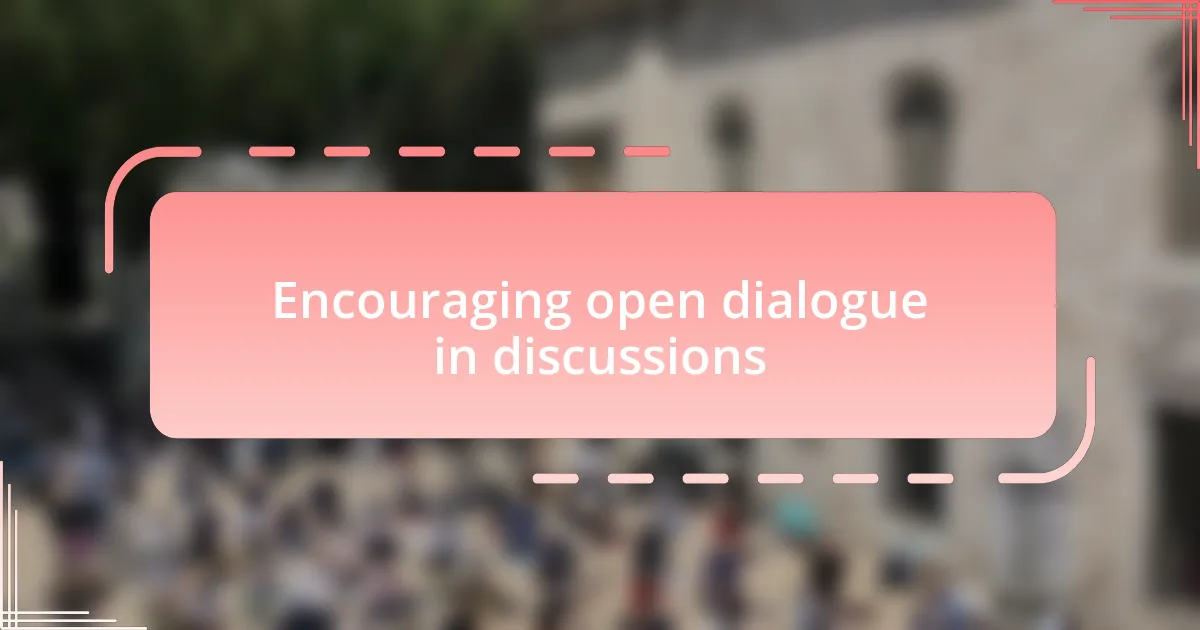
Encouraging open dialogue in discussions
Creating an environment for open dialogue in discussions involves more than just asking questions; it’s about actively listening and validating student voices. I vividly remember a classroom discussion on moral dilemmas where I encouraged students to express their views freely, no matter how controversial. Their responses varied widely, but what struck me was the sense of respect they developed for differing opinions as we navigated the topic together. Isn’t it rewarding to see students learning to appreciate different perspectives?
When fostering open dialogue, I often start by sharing my own uncertainties and questions. During a reflective session on faith, I admitted to grappling with certain beliefs. This honesty sparked a lively exchange where students felt compelled to share their own uncertainties. I found joy in guiding them as they explored these challenging topics, and their willingness to engage deeply with both their peers and their own thoughts was truly inspiring.
Furthermore, I make it a practice to incorporate moments of silence after posing a question. This pauses allows students to reflect and gather their thoughts before they share. One day, after asking about their views on ethics in religious teachings, I noticed a palpable shift in the atmosphere. Students who normally hesitated to speak began to articulate their ideas with confidence. It made me realize how powerful it can be to simply give them the time and space to voice their thoughts, don’t you think?
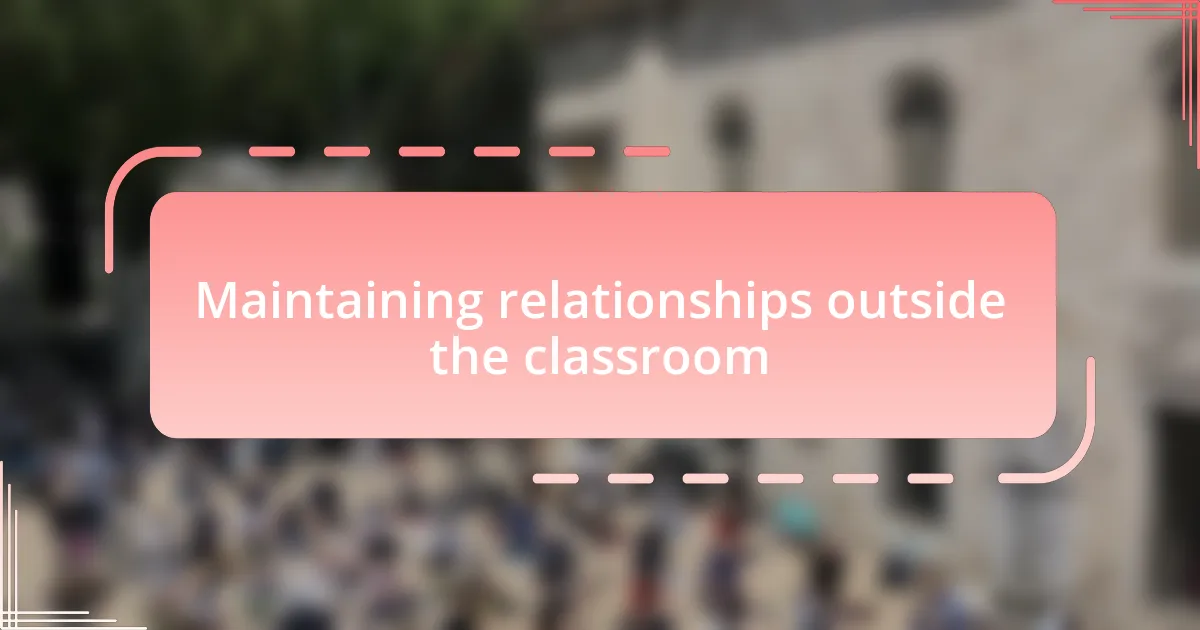
Maintaining relationships outside the classroom
Maintaining relationships outside the classroom is vital for fostering a supportive learning environment. I’ve often found that simple gestures, like sending a quick message to check in on a student after a challenging exam, can make a significant difference. One time, I reached out to a student who seemed particularly stressed. When they responded, sharing their struggles, I felt a strong connection form that transcended the classroom walls. Isn’t it interesting how a small act can lead to deeper trust?
Another way I stay engaged with my students outside of formal settings is through extracurricular activities. I remember volunteering alongside students during a community service project. Seeing them in a different light, working hard for a cause, helped me understand their passions and challenges better. It also opened up new avenues for conversations that we could later bring back to our discussions about ethics and morality. Have you ever noticed how shared experiences can strengthen bonds?
I also enjoy leveraging social media to connect with my students. In a recent choir event, I snapped some candid photos and posted them online. I was pleasantly surprised by the positive response; many students commented and shared their experiences from the event. This not only reinforced our shared memories but also made it easier to approach discussions about faith and community in class. It’s fascinating how technology can bridge gaps and keep relationships thriving even when we’re not face-to-face, isn’t it?